Overview
EquiMoves is a tool that equine vets, trainers and breeders can use for lameness exams, pre-purchase tests and sport horse monitoring.
Traditionally, vets have been able to evaluate the movement of horses visually. But the human eye is only capable of capturing images with a frequency of 20Hz (20 images per second). This makes the human capacity for assessment insufficient in order to arrive at a consistent and objective evaluation of the functioning of the horse’s loco-motor system, especially when diagnosing lameness – much less when predicting a horse’s performance.
The EquiMoves technology is based on wireless inertial sensors placed at the head, withers, sacrum and cannon bones of the horse which can offer objective and unbiased information.
EquiMoves has been used for research purposes by Utrecht University and several other universities around the world. EquiMoves has now expanded this technology to the clinical setting bringing objective and lameness assessment to a completely new level.
System highlights
- Quantitative gait analysis offers objective and unbiased information which can be valuable during a lameness examination.
- Kinematic methods can be used to quantify changes in locomotion due to lameness.
- Gait analysis using wireless inertial sensors have good potential for clinical application.
- Repeated measurements (e.g. before and after diagnostic anaesthesia or treatment) may have highest clinical relevance.

Advantages of EquiMoves
Innovation
- The only mobile equine gait analysis system in the world that measures and produces reports in all gaits & all surfaces.
- The only mobile equine gait analysis system in the world that has sensors on the upper body & on the legs.
- EquiMoves provides the best accuracy and precision on the market.
- It captures movements that might be close to impossible to detect with the naked eye.
Ease of use
- The system is wireless and mobile.
- Measurements can be started or stopped anytime during the normal procedure of the lameness exam.
- Horses can be assessed in hand, ridden or driven.
- The workflow is designed to interfere as little as possible with your normal workflow.
Quick results
- Results are displayed within seconds after the measurement is finished.
- A full lameness exam (walk, trot and canter) can be reported.
- It is easy to compare results from different assessments or even different visits.
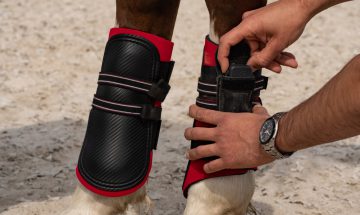
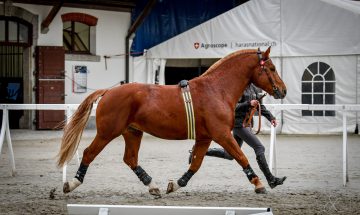
Photo by Christelle Althaus 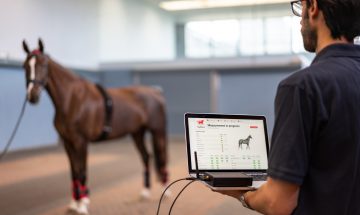
EquiMoves system setup
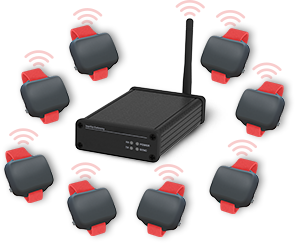
1. Hardware
Wireless inertial sensors for capturing motion data are attached to the legs, the withers, the sacrum, and the head of the horse. The sensor data is streamed to a gateway connected to the computer. Having a wireless and mobile system makes assessments easy and integrated in the clinical workflow.
Placing sensors is completely non-intrusive for the horse and does not disturb the normal movement pattern of the horse.
In the standard setup seven wireless inertial sensors are used to measure the horse in all gaits.

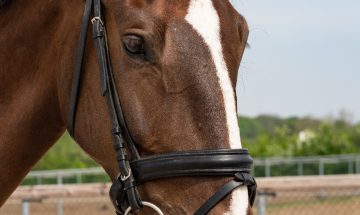
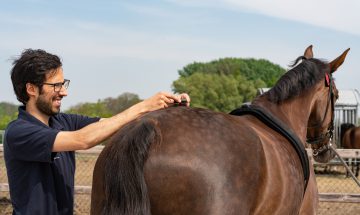
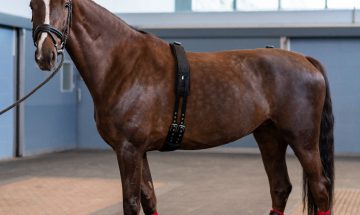

Photo by Christelle Althaus 
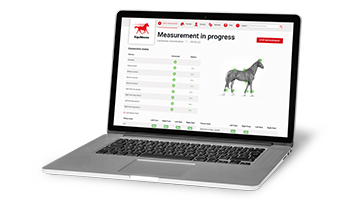
2. Software
The EquiMoves motion processing software computes the relevant parameters and analyzes the horse’s gait for lameness and performance assessment.
With our own tailor-made asymmetry analysis tool objective and quantitative lameness analysis is quick, easy and comprehensible. EquiMoves quantifies these asymmetries in an easy and understandable way as an objective complement to your subjective evaluation.
The system also provides stride related information with the best accuracy and precision on the market. This enables you to capture movement that might be close to impossible to detect with the naked eye. The interface is designed to show asymmetries in a variety of ways, ranging from an easy overview to in depth stride by stride information.
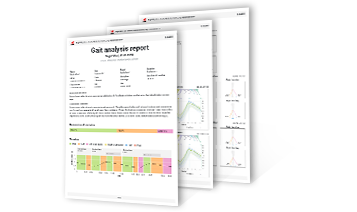
3. Reports
The EquiMoves software is paired with quick and easy comparisons of measurements and a report function, making it cutting edge technology for objective lameness assessment.
The EquiMoves software generates a report of the measurements, split in events and gaits. A full lameness exam (walk, trot and canter) can be reported. Is the horse symmetric or does it have an impact lameness (MinDiff) or push-off lameness (MaxDiff)? The sensor at the head indicates a front limb lameness and the sensor at the sacrum indicates a hind limb lameness.
In a lot of cases horses will have an asymmetry at the head and the sacrum. In this case we will use also the information of the sensors at the withers for indicating the primary source of lameness.
Request more information
If you are interested in using EquiMoves in your activities please send us a message and we will be happy to give you more information.
EquiMoves in campaign about social license
In the ‘This is What Horses Do’ campaign, created by the Horse Sector Council in the Netherlands (Dutch translation: Sectorraad Paarden), attention was given to the gait patterns of horses through a lameness exam. For this study, EquiMoves… Read more →
EquiMoves used in breeding
Friesians In 2010, John Voskamp and Wim Back, nowadays board member of KFPS (Royal Friesian Studbook) initiated research using inertial sensors for the KFPS. These initial trials at Stoeterij Koningsland marked the beginning of EquiMoves’ development for analyzing… Read more →
Using Different Combinations of Body-Mounted IMU Sensors to Estimate Speed of Horses – A Machine Learning Approach
Hamed Darbandi, Filipe Serra Bragança, Berend Jan van der Zwaag, John Voskamp, Annik Imogen Gmel, Eyrún Halla Haraldsdóttir and Paul Havinga Sensors 2021, 21(3), 798; https://doi.org/10.3390/s21030798 Speed is an essential parameter in biomechanical analysis and general locomotion research.… Read more →
